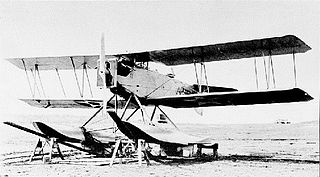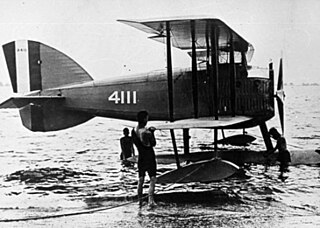
The Northrop C-19 Alpha was a series of three aircraft purchased from Northrop by the US Army Air Corps in 1931. They were slightly modified versions of the civil Northrop Alpha Type 2.

The X-26 Frigate is the longest-lived of the X-plane programs. The program included the X-26A Frigate sailplane and the motorized X-26B Quiet Thruster versions: QT-2, QT-2PC, and QT-2PCII. All were based on the Schweizer SGS 2-32 sailplane.

The twin-engine F5L was one of the Felixstowe F series of flying boats developed by John Cyril Porte at the Seaplane Experimental Station, Felixstowe, England, during the First World War for production in America.

The Zeppelin-Staaken R.VI was a four-engined German biplane strategic bomber of World War I, and the only Riesenflugzeug design built in any quantity.

The Aeromarine PG-1 was an American single-seat pursuit (fighter) and ground attack (PG) biplane developed by the Engineering Division of the United States Army and manufactured by the Aeromarine Plane and Motor Co..

The Aeromarine 39 was an American two-seat training seaplane ordered by the US Navy in 1917 and built by the Aeromarine Plane and Motor Company of Keyport, New Jersey. Of conventional biplane configuration and construction, the aircraft was designed so that its pontoons could be speedily detached and replaced with wheeled undercarriage for shore operations.

The Felixstowe F.5 was a British First World War flying boat designed by Lieutenant Commander John Cyril Porte RN of the Seaplane Experimental Station, Felixstowe.

The Aeromarine 40F was an American two-seat flying-boat training aircraft produced for the US Navy and built by the Aeromarine Plane and Motor Company of Keyport, New Jersey. Fifty out of an original order for 200 were delivered before the end of World War I, with the remainder cancelled due to the armistice.

The Aeromarine AS was a seaplane fighter aircraft evaluated by the US Navy in the early 1920s.

The Consolidated PT-1 Trusty was a biplane primary trainer used by the United States Army Air Service (USAAS).
The Short Admiralty Type 74 was a single-engined biplane tractor seaplane with non-folding wings, which saw service with the Royal Naval Air Service during the First World War.

The Ikarus ŠM, ŠM was the first design of Eng. Josip Mikl for the Yugoslav company Ikarus, it was a side-by-side two-seat biplane flying boat powered by a 100 hp (75 kW) Mercedes engine. The aircraft used for training by the Yugoslav Royal Navy.

The Savoia-Marchetti S.59 was a 1920s Italian reconnaissance/bomber flying boat designed and built by Savoia-Marchetti for the Regia Aeronautica.

The Sperry Messenger was an American single-seat biplane designed by Alfred V. Verville working for the Engineering Division of the United States Army Air Service (USAAS) and built under contract by Sperry Aircraft Company of Farmingdale, New York. The aircraft was later designated the M-1 and MAT by the USAAS. Sperry produced approximately 50 Messengers and the civilian two-seat version, the Sport Plane, between 1920 and 1926. The aircraft was the first to make contact between an airplane and an airship while in flight.

The Heinkel HD 22 was a trainer designed in Germany during the 1920s. It was a conventional single-bay biplane with staggered wings braced with N-type interplane struts. The pilot and instructor sat in tandem, open cockpits, and the main units of the fixed, tailskid undercarriage were linked by a cross-axle.

The Naval Aircraft Factory TG were a series of prototype seaplanes for gunnery training designed and built by the United States Navy's Naval Aircraft Factory.

The Curtiss HA was an American biplane seaplane designed by Captain B.L. Smith of the United States Marine Corps, and built by Curtiss Aeroplane and Motor Company.

The Aeromarine 50, also called the Limousine Flying Boat, was a luxury seaplane.
The Aeromarine EO was a light sport flying boat that was built in the mid-1920s.

The LWF model H Owl was a large American twin-boom trimotor biplane designed and built by LWF Engineering as a mail plane in 1920, but after being rejected for that role, the single prototype was sold to the United States Army Air Service for evaluation as a bomber but failed to secure any orders.



















